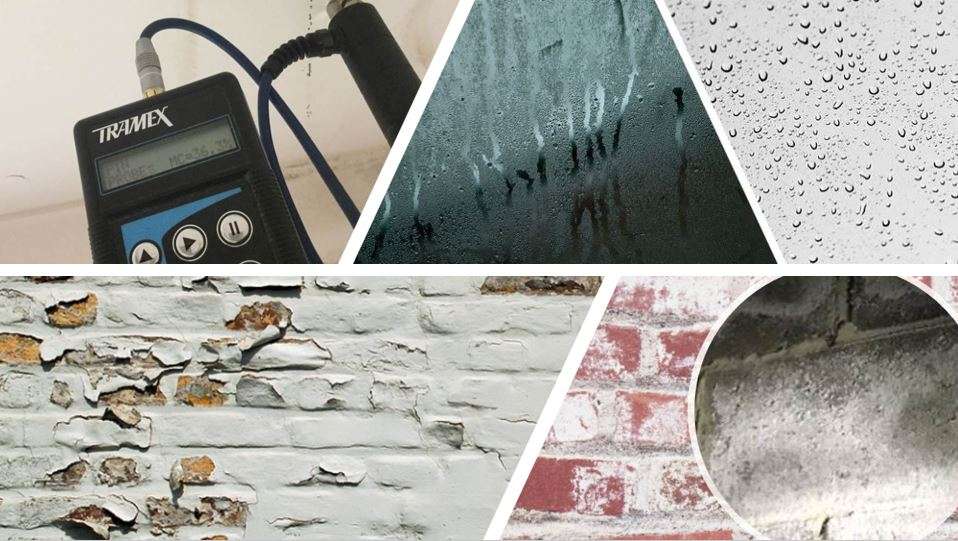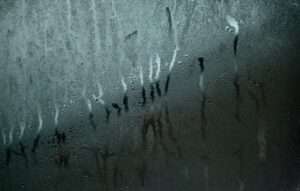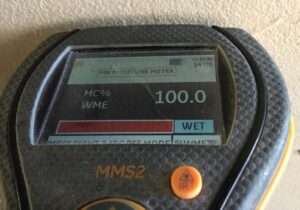As you might expect, when we are doing leak detection in the York & Yorkshire Coast area, we frequently come across properties with damp on walls, sometimes this is caused by water leaks (more on this later) but there are a few common causes which we will explain in this article.
It is important to get to the bottom of damp on walls in your home or business as, not only can it cause damage to the structure of the fabric of your building but also because it can cause other issues, such as mould on walls. As experts in damp and mould, we are experienced in finding and diagnosing different causes of damp on walls but also making recommendations as to how to best remedy the problem to help prevent future issues.

All our front like technical staff are trained water damage management practitioners and diagnosing and dealing with damp on walls, floors or ceilings in your home or business is something they are very experienced in. We discuss this further in our guide to water leak repair stages.
Damp on Walls – What are the Main Causes?
Damp on walls can be caused by a number of things, but we have narrowed it down to the four most common causes we come across and what each of them means. Before we go into detail on each of these, here is a quick summary of each of them:
- A Water Leak – for example from a leaking pipe in a wall (fresh or waste water)
- Condensation on Walls – building up and causing damp problems
- Rising Damp – moisture rising from the ground into the building fabric
- Penetrating Damp – moisture coming in from externally through walls
As you will see later in this article, some of these sound simple and straightforward. However, each of these can have different causes (of which there can be many) but we will explore this further later down this page!
Because we also provide commercial leak detection, we are also familiar in diagnosing damp problems in a wide variety of business premises, whether that be damp on walls, floors or ceilings in properties across the York and Yorkshire Coast area of the UK.
Damp on Walls 1 – Water Leaks
Unsurprisingly, as providers of trace and access services, we come across water leak in walls regularly. In fact, it is one of the places we prioritise when looking for leaks, especially central heating leaks when someone has their boiler pressure dropping. Central heating pipes commonly run through walls or up walls to floors above.
Damp on walls caused by water leaks don’t always appear immediately after your water leak starts, it can take days, weeks, months or even years for someone to notice it. This is especially the case with small leaks. Even then a huge amount of water can leak out, as we showed in our article about how much water a leak wastes.

In order to find leaks in walls, we utilise various leak detection equipment, including:
- Thermal Imaging Leak Detection
- Moisture or Damp Meters
- Moisture Mapping Leak Detection
- Tracer Gas Leak Detection
- Acoustic Listening Leak Detection
- Water Pipe Tracing Leak Detection
- Water Flow and Pressure Testing Leak Detection
- Salts Analysis Tests to determine the water source
- Other miscellaneous leak detection tools and devices
- All combined into our bespoke tracking and reporting tool
All of these specialist leak detectors, along with our skills and experience helps to maximise the chances of finding water leaks in a wall, ceiling, floor (including underground leaks or basement water leaks) or elsewhere.
On this subject, see our useful article on finding a water leak in concrete floors.
Top Tip
Leak Detection Team
“If you spot unexplained damp on walls in your home or business, do not ignore it. Contact us and we will help to see if you have a water leak, and if not, help explain what else will be causing it. Whatever you do, don’t ignore it as the damage could get worse”
Damp on Walls 2 – Condensation Problems
We have written a separate detailed article about condensation causes, including condensation causing damp on walls. As you can see in that article, it is a fairly complicated subject in its own right, but we’ll cover the basics.
Interestingly, when people have damp on walls in their property, they tend to thing of the other 3 things on this list – a water leak, rising damp or penetrating damp but condensation is an equally, if not more common cause. This is especially the case when looking at damp and mould problems in properties across the region, which can involve the use of air scrubbers (to help improve air quality) and other restoration equipment too.
The good thing about condensation causing damp on walls is that, quite often, it is a simpler thing to remedy in the longer term. In fact, when we do damp or condensation surveys in properties, not only will we help to identify what is causing the condensation but also make recommendations on how to reduce or remove condensation in your home or business. As you might expect, the recommendations will be closely tied to the causes.
If you have a problem with damp or condensation at your property, get in touch with us and we will help and advise you – our remote monitoring systems can help with this too.

Damp on Walls 3 – Rising Damp
Of all the things on this list, when looking at damp on walls, people tend to immediately think they might have rising damp. This is especially if the damp is at a low level on the ground floor or a property. But, in actual fact, it is perhaps not as common as people think. That is not to say it is an especially rare occurrence either.
So, what is rising damp? – basically, rising damp is moisture rising up walls or other vertical structure materials in your property. It rises through the fabric of the buildings including through timber, bricks & mortar, damp plaster and other materials.
Rising damp tends to be more common in older properties, especially if they don’t have (or have a compromised) damp prove membrane / course. As we have a lot of older properties in the York area, we do see it fairly often. That said, it is not exclusive to old properties by any means, especially if there is structural damage.
We have specialist methods and equipment to help diagnose damp in your property.
One of the methods we use to diagnose and understand rising damp in a property is salts tests. Basically, salts tests help to test the moisture found in the fabric of the building at look for chlorides (most commonly found in tap originating water) and nitrates (more commonly found in ground water sources – many types).

Damp on Walls 4 – Penetrating Damp
Like some of the other things on this list, penetrating damp associated with damp on walls is something that is often misunderstood, and misdiagnosed if you are not careful and use the right techniques to understand the problem.
What is penetrating damp? – penetrating damp on walls tends to be moisture (which is most commonly externally originating) penetrating the materials of the property and manifesting itself inside, often as damp on walls. There can be a number of reasons for this, but the age, construction and condition of a property all can have a big part to play in penetrating damp problems.
Penetrating damp tends to be more common on properties without a cavity wall as the moisture tracks through solid or ‘single skin’ walls. After all, in part, cavity walls are there to help prevent penetrating damp. Penetrating damp can be also caused by (or made worse by) storm damage too.
Penetrating damp on walls can often be misdiagnosed as rising damp, in part because it can look fairly similar but it is important not to confuse the two as they are very different, and so are the remedies for them. If you are interested in further reading materials on damp, the wikipedia page on structural damp is an interesting and informative read.
We are experts in dealing with many types of water damage for people in the York and Yorkshire Coast area, so if you have damp in York or the Yorkshire Coast area, please contact our friendly team to arrange for help and guidance. We also deal with water leaks in Yorkshire homes and businesses. Here are the local areas we cover and services we offer locally.
At Rainbow Restoration – York & Yorkshire Coast we are Damage Management experts – in Leak Detection and Water Damage Restoration, so if you need help finding a water leak or getting your property back to normal after a leak or flood, get in touch with our friendly local team who will be happy to help you with this.
How do you fix damp walls?

When deciding how to fix damp walls, one of the most important things to understand is what is causing the damp problem in the first place. Otherwise, you might repair it only for the problem to return later. Once you understand the cause, and have remedied it, then you consider the best fix. Clearly this will then depend on the scale of damp, what areas and materials are affected, if they can be repaired (or need replacing), the age and condition of the property, if drying is required and other factors. Of course what your budget for a repair is important too as you will likely have different options with varying costs.
Is a damp wall harmful?

A damp wall can potentially be harmful for a number of reasons. These include the fact that it could be causing damage to the fabric of your building which can then cause structural damage or risks. Also, damp walls can be a breeding ground for mould problems to form in your home or business. In turn, mould can affect the air quality and potentially cause respiratory problems for those coming into contact with it, especially vulnerable people or those with medical issues etc.
When should I worry about damp walls?

If you spot damp on walls in your property, then it is definitely advisable to look into the cause of it as soon as possible. Otherwise, you risk causing damage to your property and / or have secondary issues like mould problems (which is unpleasant). The key thing is to get to the bottom of what is causing damp on walls, that way you can understand the best resolution. A damp expert such as ourselves can help and, if it is caused by a water leak, help you find the leak!

